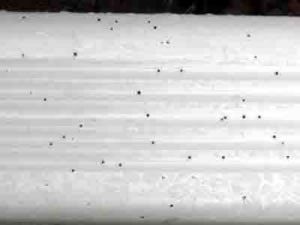Affordable Powerwash Resources
Artillery Fungus
Protect Yourself from Fungi
People are concerned by the tiny dark spots they find on their houses, cars, and plants. Often the spots are mistaken for scales. The spots may actually be spores from members of a group of Fungi commonly known as the “shotgun” or “artillery” Fungi in the genus Sphaerobolus. These fungi colonize dung or other organic matter, such as wood mulch, wood benches, and sheds.
Artillery fungi use an interesting mechanism to disperse their spores. Dark brown spore packets, called peridioles, sit on top of specialized cup-shaped cells that accumulate water and contents. When enough liquid is accumulated, the cupped cells invert, causing the cells to burst and propel the peridoles as high as 6 meters, where they can adhere to new surfaces.
Symptoms
The fungi appear as yellow-brown to black, disc-shaped spots about 1-2 mm. They can be found on any surface due to a sticky substance (i.e., Mother Nature’s version of “super glue”) covering the periodole that allows for good adherence. The fungi are very sensitive to light, and the spores are projected toward it, so they are frequently located on white and light colored surfaces (house siding, white cars, etc.) or other bright, light-reflecting bases.
Management Strategies

Artillery fungi spores do generally not structurally damage the houses, cars, plants, etc., they cover. Removing the fungi is virtually impossible. Scrubbing and scraping with tools or washing with soap and water aids somewhat in removal; however, using tools or harsh chemicals may damage painted or otherwise colored surfaces. No fungicide treatment is recommended at this time.
Lately, the appearance of artillery fungi have been associated with wood mulch (versus bark mulch) and the increased use of wood products in potting media. Composting of these products before incorporation into media is encouraged to prompt the growth of beneficial antagonistic organisms. Also, using gravel mulch, stone, pea gravel, and black plastic next to buildings instead of using wood products will help reduce the problem. If wood products are used, the addition of about 3 cm of fresh mulch to cover products, may also lessen fungal spread.
One word of warning to homeowners wishing to replace house siding splattered by artillery fungi –
Insurance companies may not cover claims of damage done due to “molds”.
Aluminum Siding Facts
Things You Should Know About Aluminum Siding
When aluminum siding was introduced to the market about 50 years ago, It was touted as a long-lasting, maintenance-free alternative to traditional sidings such as wood shingles and clapboard.
Since aluminum siding is rot-proof, waterproof, and corrosion resistant it will withstand years of exposure to the elements of nature. In fact, aluminum siding will virtually last forever. However, the same can not be mentioned for that layer of chalky, porous, fading paint that stands between the siding and the rest of the world.
Aluminum siding not only fades and chalks, but like any other siding, It also gets dirty with mildew and grime. Affordable Powerwash is experienced with this situation and knows how to use the proper precautions that must be taken when cleaning it.
When properly cleaned, aluminum siding can and will look better. However, If not appropriately cleaned, aluminum siding can look streaky. These streak marks occur from too much cleaning pressure being applied to heavily oxidized areas.
When heavily oxidizing areas are not properly cleaned, the chalky, fading paint washes off, and the bare aluminum gets exposed, causing those ugly streak marks.
We will inform the homeowner if they feel that pressure washing the aluminum will cause a negative appearance to it. In this case, we will only pressure wash the aluminum siding with written consent from the homeowner.
